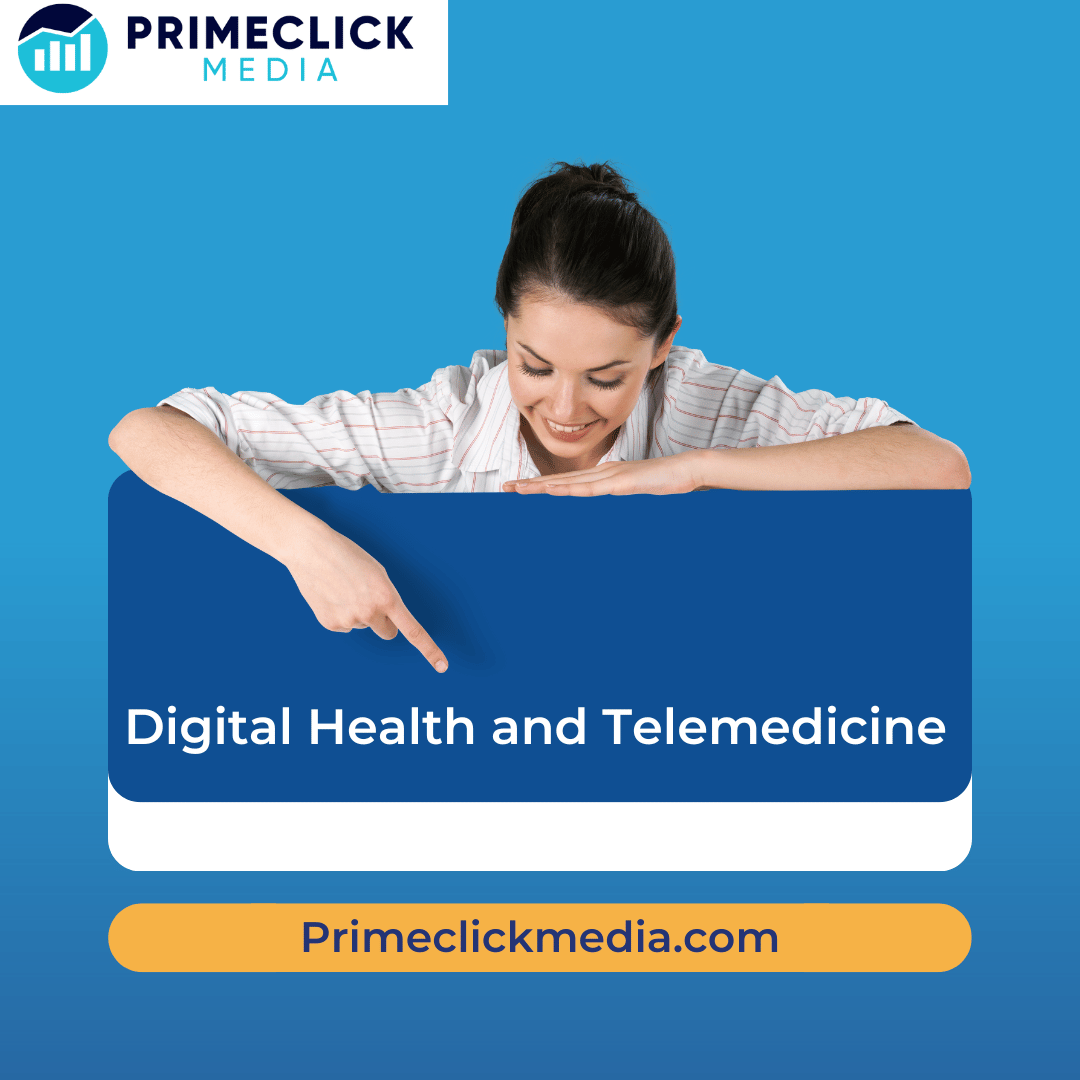In a world buzzing with technology, something amazing is happening in the realm of healthcare. It’s called “Digital Health” and “Telemedicine,” and they’re changing the way we stay healthy and get medical help.
Let’s dive into this exciting world and see how it’s making our lives better.
Digital Health: Your Health Buddy
Digital health refers to the use of digital technologies, such as computers, smartphones, wearable devices, and health-related apps, to improve and enhance healthcare services, patient care, and overall well-being. It encompasses a wide range of technologies and applications that aim to revolutionize the way healthcare is delivered, managed, and accessed.
In simpler terms, digital health harnesses the power of technology to make healthcare more personalized, convenient, and efficient. It’s like having a virtual toolkit that empowers individuals, patients, and healthcare professionals to monitor health, manage medical conditions, and access medical information anytime, anywhere.
Digital health can include:
- Health and Wellness Apps: These are smartphone apps that help you track various aspects of your health, such as fitness, nutrition, sleep, and mental well-being. They provide insights, advice, and tools to promote healthier lifestyles.
- Wearable Devices: Devices like fitness trackers, smartwatches, and medical wearables can monitor your heart rate, activity levels, sleep patterns, and more. They provide real-time data that can help you stay on top of your health goals.
- Telemedicine: Telemedicine enables virtual doctor’s appointments through video calls or online chats. It allows patients to consult with healthcare professionals remotely, providing medical advice, prescriptions, and consultations without the need for physical travel.
- Electronic Health Records (EHRs): EHRs are digital versions of a patient’s medical history, test results, and treatment plans. They make it easier for healthcare providers to access and share patient information securely.
- Remote Monitoring: This involves using technology to monitor patients’ health remotely, especially for those with chronic conditions. Devices can transmit data like blood sugar levels, blood pressure, and more to healthcare providers for analysis and timely intervention.
- Digital Therapeutics: These are software-based interventions that help manage, treat, or prevent medical conditions. They could include mobile apps that provide cognitive behavioral therapy or assist in managing chronic pain.
- Genomic Information: Digital health can involve analyzing a person’s genetic information to provide personalized insights into their health risks, predispositions, and potential treatments.
- Healthcare Chatbots: Chatbots powered by artificial intelligence can provide basic medical information, answer health-related questions, and even help schedule appointments.
- Virtual Reality (VR) and Augmented Reality (AR): These technologies can be used in medical training, pain management, and therapy, creating immersive and interactive experiences for patients and healthcare professionals.
Telemedicine: Your Doctor on Screen
Telemedicine refers to the use of telecommunications technology, such as video calls, phone calls, and secure messaging, to provide remote medical consultations, diagnoses, treatment, and healthcare services. It enables patients to connect with healthcare professionals without the need for in-person visits, making medical care more accessible, convenient, and efficient, especially in situations where physical presence is challenging or unnecessary.
In essence, telemedicine brings the doctor’s office to you, allowing you to receive medical attention from the comfort of your own home or any location with an internet connection. It leverages digital communication tools to bridge the gap between patients and healthcare providers, offering a wide range of healthcare services remotely.
Key features of telemedicine include:
- Virtual Doctor’s Appointments: Telemedicine allows patients to schedule and conduct appointments with healthcare professionals via video calls. During these virtual visits, patients can discuss their symptoms, and medical history, and receive medical advice or treatment recommendations.
- Diagnosis and Treatment: Healthcare providers can use telemedicine to assess a patient’s condition, make diagnoses, and recommend appropriate treatment options. They can prescribe medications, order laboratory tests, and provide medical guidance remotely.
- Follow-Up Care: Telemedicine is often used for follow-up appointments after an initial in-person consultation. This is especially useful for monitoring chronic conditions, adjusting treatment plans, and tracking progress.
- Mental Health Services: Telemedicine is widely used for mental health counseling and therapy. Patients can receive counseling sessions, therapy, and support from mental health professionals through virtual platforms.
- Specialist Consultations: Telemedicine allows patients to access specialized medical expertise, even if the specialist is located in a different city or region. This is particularly beneficial for individuals who require rare or specific medical consultations.
- Emergency Consultations: In some cases, telemedicine can be used for urgent medical consultations, such as assessing injuries or symptoms to determine whether a visit to the emergency room is necessary.
- Remote Monitoring: Telemedicine can involve the use of wearable devices and remote monitoring tools to collect and transmit medical data, such as heart rate, blood pressure, and glucose levels, to healthcare providers for ongoing assessment.
Why Telemedicine is a Game-Changer
Telemedicine is a true game-changer in the world of healthcare, revolutionizing how medical care is delivered and accessed. Its impact is far-reaching and transformative, offering numerous benefits that enhance patient experiences, improve healthcare outcomes, and address various challenges within the traditional healthcare system. Here’s why telemedicine is considered a game-changer:
- Accessibility for All: Telemedicine breaks down barriers to healthcare access, especially for individuals in remote or underserved areas. People who previously had limited access to medical facilities can now connect with healthcare professionals without the need for long journeys.
- Convenience: Telemedicine offers unparalleled convenience. Patients can consult with doctors, specialists, or therapists from the comfort of their homes or workplaces, eliminating the need for travel, waiting rooms, and time off work.
- Faster Access to Care: Waiting for an available appointment slot can be frustrating and even detrimental to health in some cases. Telemedicine reduces wait times, enabling patients to receive timely medical attention, advice, and treatment, which is crucial for acute conditions or emergencies.
- Continuity of Care: Telemedicine facilitates continuous monitoring and follow-up care, especially for patients with chronic conditions. Healthcare providers can track progress, adjust treatment plans, and offer ongoing support without requiring frequent in-person visits.
- Reduced Healthcare Costs: Telemedicine can lead to cost savings for both patients and healthcare systems. Patients save money on transportation, parking, and other associated costs, while healthcare providers can streamline operations and potentially reduce overhead expenses.
- Flexibility for Providers: Telemedicine offers flexibility to healthcare professionals, allowing them to reach a broader patient base without geographical limitations. This can be especially beneficial for specialists who can provide consultations to patients across different regions.
- Preventive Care and Health Monitoring: Telemedicine supports preventive care by encouraging regular check-ins and health monitoring. Patients can receive guidance on maintaining a healthy lifestyle, managing chronic conditions, and preventing potential health issues.
- Mental Health Support: Telemedicine plays a vital role in addressing mental health needs. Many individuals who might have been hesitant to seek therapy in person can access confidential mental health support through virtual platforms.
- Pandemic Preparedness: The COVID-19 pandemic highlighted the importance of telemedicine in maintaining healthcare services while minimizing the risk of virus transmission. Telemedicine provided a safe way for patients to receive care, reducing strain on healthcare facilities.
- Global Health Impact: Telemedicine has the potential to make a significant impact on global health initiatives. It enables medical professionals to provide remote consultations and training in areas where access to healthcare is limited.
- Health Equity: Telemedicine can contribute to reducing health disparities by providing equal access to quality healthcare regardless of factors like location, socioeconomic status, or physical mobility.
- Innovation and Technological Integration: Telemedicine leverages the latest advancements in technology, such as video conferencing, wearable devices, and electronic health records. This integration drives innovation and enhances the overall patient experience.
How Telemedicine Works
Telemedicine works by utilizing digital communication technologies to connect patients with healthcare providers remotely. It enables medical consultations, diagnoses, treatment, and healthcare services to be delivered virtually, allowing patients to receive medical care without the need for in-person visits. Here’s a step-by-step breakdown of how telemedicine works:
- Scheduling and Appointment: The process typically begins with a patient scheduling a telemedicine appointment. This can often be done through a telemedicine platform, website, or app provided by the healthcare facility or practitioner. Some healthcare providers may also offer telemedicine as an option during regular appointment scheduling.
- Choosing a Communication Platform: Once the appointment is scheduled, the healthcare provider and patient determine the preferred mode of communication for the telemedicine visit. Common options include video calls, phone calls, secure messaging, or a combination of these methods.
- Preparing for the Visit: Patients may need to complete any necessary paperwork or provide relevant medical history and information before the telemedicine appointment. This ensures that the healthcare provider has accurate and up-to-date information to provide effective care.
- Connecting Virtually: At the appointed time, both the patient and the healthcare provider log in to the chosen telemedicine platform or communication tool. If a video call is selected, the patient and provider can see and hear each other through their respective devices’ cameras and microphones.
- Discussing Symptoms and Concerns: During the virtual visit, the patient discusses their symptoms, medical history, and any concerns they have with the healthcare provider. The provider may ask questions, visually assess the patient’s condition, and provide medical guidance.
- Diagnosis and Treatment: Based on the information shared and observed during the virtual visit, the healthcare provider makes a diagnosis, recommends treatment options, prescribes medications, or suggests further tests or evaluations if needed.
- Providing Medical Advice and Education: The healthcare provider offers medical advice, educates the patient about their condition, and discusses any necessary lifestyle changes or follow-up care. They may also answer any questions the patient has.
- Prescriptions and Referrals: If the patient requires medication, the healthcare provider can electronically send prescriptions to a local pharmacy. Additionally, if the patient needs to see a specialist or undergo further testing, the provider can make referrals as necessary.
- Follow-Up and Ongoing Care: For ongoing conditions or follow-up appointments, the telemedicine platform can be used to schedule subsequent virtual visits. This ensures continuity of care and allows the provider to monitor the patient’s progress.
- Privacy and Security: Telemedicine platforms prioritize patient privacy and security by adhering to strict data protection standards and encryption protocols. This ensures that sensitive medical information remains confidential and secure during the virtual visit.
- Insurance and Payment: Many telemedicine services are covered by health insurance plans. Patients may need to provide insurance information or make payment arrangements, similar to an in-person visit.
- Technical Support: Telemedicine platforms often offer technical support to assist patients with any connectivity or usability issues they may encounter during the virtual visit.
The Perks of Telemedicine
Telemedicine isn’t just cool; it’s full of awesome benefits. It saves you time and money because you don’t have to travel anywhere. No waiting rooms, no long drives – just quick medical help. It’s also a hero when it comes to staying safe from germs. No need to be around sick people in a waiting room. And guess what? It’s good for the planet too – fewer cars on the road mean less pollution!
Future Excitement
The future of digital health and telemedicine is super exciting. Think about having devices that can talk to each other and send your health info to your doctor. It’s like having a team of health experts working together to keep you well. And don’t forget about super-smart robots that can help with surgeries, making them safer and more precise.
A Word of Advice
While digital health and telemedicine are fantastic, remember that they can’t do everything. Serious health issues might still need a visit to a real doctor in person. Also, be careful and only use trusted apps and websites to protect your privacy.
In a world where technology is like a wizard’s wand, digital health, and telemedicine are casting spells of good health and convenience. They’re turning our phones and computers into tools for wellness and healing. So, whether you’re checking your steps or chatting with a doctor on a screen, embrace these digital wonders and let them be your partners in the journey to a healthier you!





